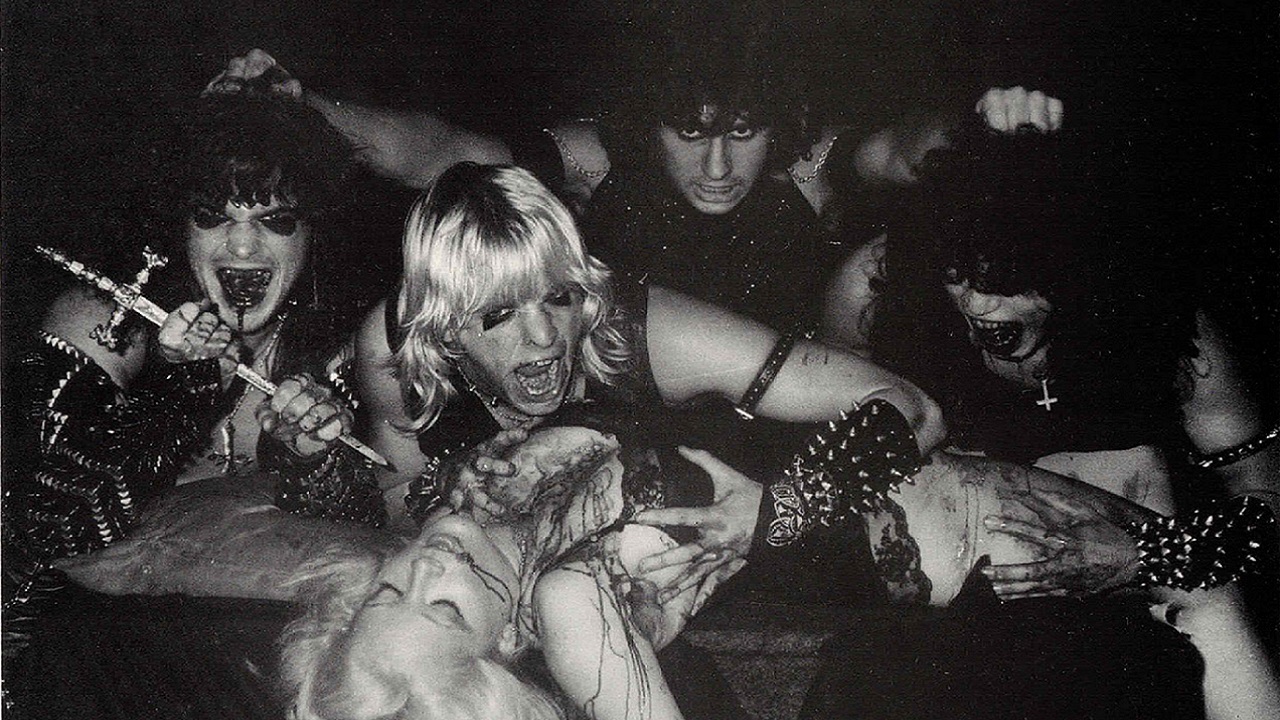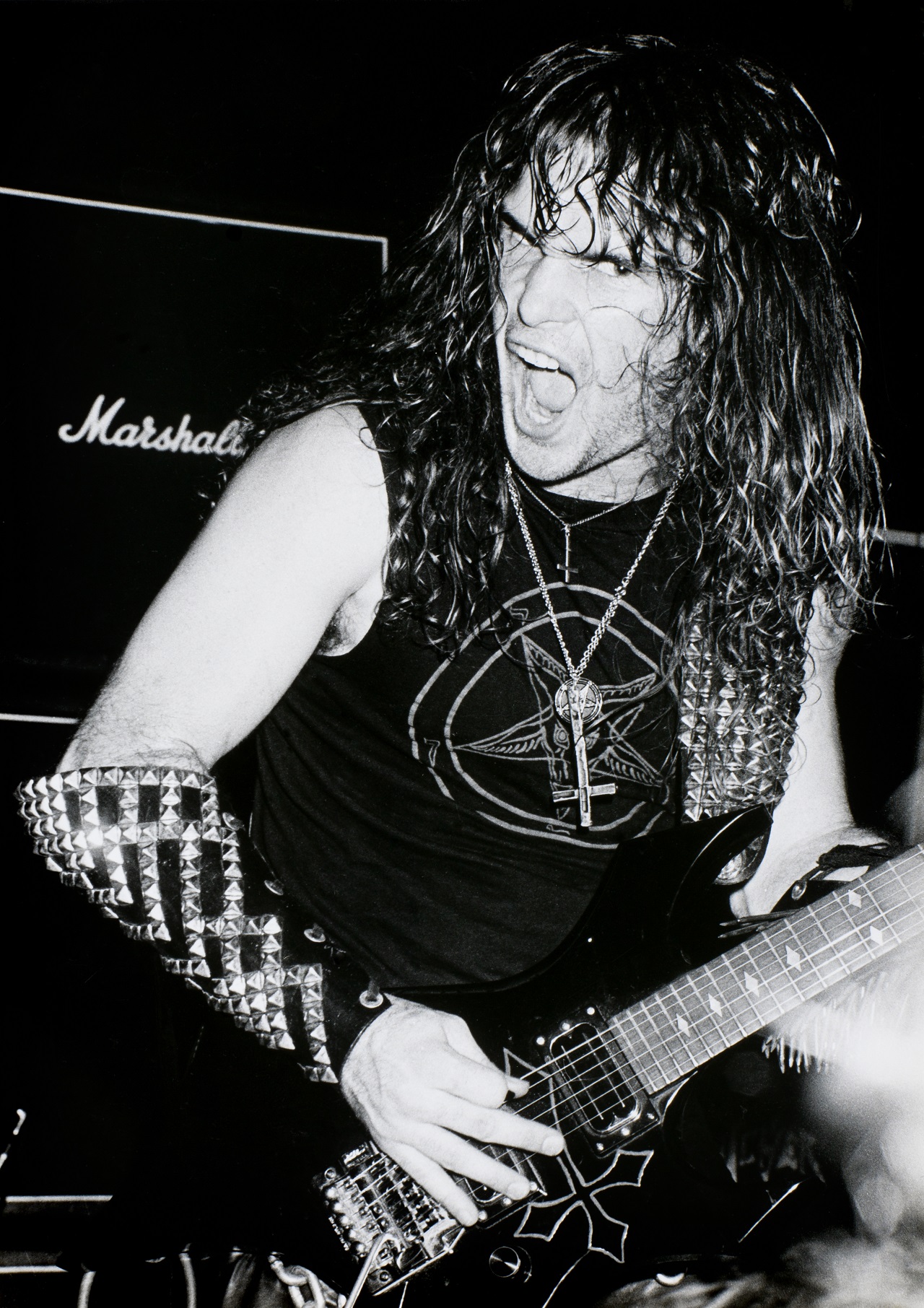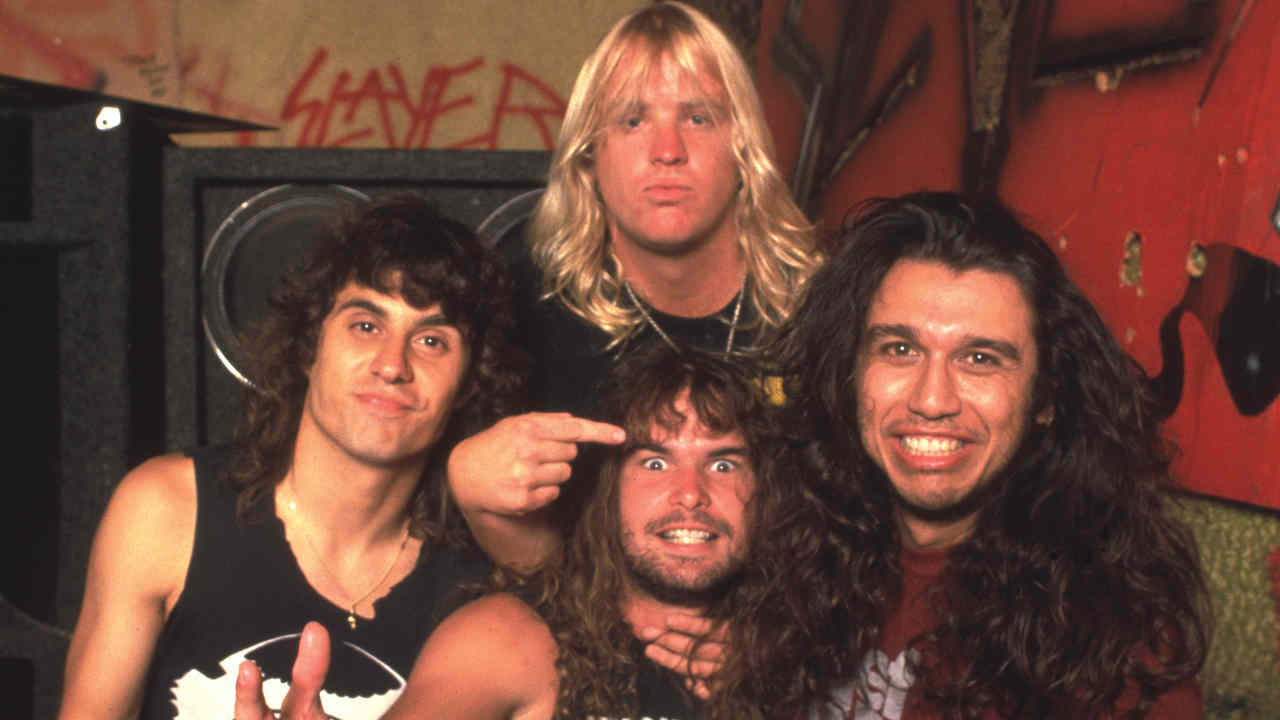
The first time Metal Blade Records founder Brian Slagel saw Slayer is burned on his brain like a pentagram. “They were opening for Bitch, which is one of the original bands we ended up signing, in Anaheim,” he says now. “There were a bunch of bands opening for them, none of whom I knew. One of those bands happened to be Slayer, and they were amazing. I could see there was something special about them.”
It was July 1983. Slayer had been in existence for little over 18 months, and they were yet to fully unfurl their black wings. But that gig set off a chain of events that started with a blown-away Brian releasing one of their songs on one of his legendary Metal Massacre compilations, and ended, 36 years later, with Slayer taking their bows at their last ever gig in November 2019, having long ago secured their place among metal’s all-time great bands.
Except that final show wasn’t so final after all. Just five years after they hung up their inverted crosses, Slayer blindsided everybody by announcing they were reuniting for a series of festival appearances in late 2024. “Have I missed playing live? Absolutely,” said guitarist Kerry King. “Slayer means a lot to our fans; they mean a lot to us.”
That news, unexpected but not unwelcome, adds another chapter to a story that stretches back to the suburbs of Los Angeles and Orange County 43 years ago. From their first gigs in tiny venues to helping lay the foundations for thrash metal, this is how that story started.
The 16-year-old Kerry King met his future bandmate Tom Araya when they were both members of a covers band called Quits in 1981. When that band fell apart, the guitarist began plotting his next move.
Kerry King (guitarist): “I was still in high school. I wasn’t the youngest one – Dave was the youngest one.”
Tom Araya (vocalist/bassist): “My life consisted of school, helping my dad, and wanting to play music.”
Kerry: “I found Jeff auditioning for another band in some warehouse. I came out from a try-out for this other band, knowing I didn’t want to do it. I come out and Jeff’s playing songs I know on a guitar, sitting at the desk. I’m like, ‘Hey, are you in a band?’ And he wasn’t.”
Jeff Hanneman (guitarist): “Kerry and I started jamming some Priest songs. That’s when he goes, ‘Hey, you wanna start a band?’ and I was like, ‘Fuck yeah!’”
Kerry: “The first time I met Dave was out the front of my house. He walked up and said, ‘Hey, you the guy with all the guitars?’ I said, ‘I have guitars. I don’t know what ‘all the guitars’ means.’”
Dave Lombardo (drummer): “Kerry gave me a list of songs that he knew on guitar, and I was impressed, because the list was really long. I knew a bunch of them, so he brought his amp over the next day and we started playing. A few rehearsals later, he brought Jeff over.”
Tom: “I got a call from Kerry: ‘Hey, I’m putting together a band, I got this guitarist and drummer, want to get together and jam?’”
Kerry: “I was big-time into Venom. I thought Cronos was the single most evil entity I’d ever seen in my life!”
Tom: “We started writing songs at our second practice. I remember Jeff was like, ‘I’ve got this song…’
Dave: “One day Jeff shows up to rehearsal with a shaved head. We were all like, ‘Whoa, Jeff, what’d you do?!” He went: ‘I’m punk. It’s over.’ And he brought all of this music with him – Black Flag, TSOL, Minor Threat, Dead Kennedys, Circle Jerks…”
Jeff: “Dave jumped on the punk bandwagon right away, but it took Kerry and Tom a little while longer. Eventually, our songs just started getting faster and faster.”
Tom: “It started with the song Aggressive Perfector. We rehearsed it 100 times. And we liked it so much, we rewrote a lot of originals that we had. That’d be the one time we said: ‘This is the direction we’re going in.’ Prior to that, we didn’t know what we wanted to do. We just did it!”

This new band, christened Slayer, played their first ever show at South Gate Park Auditorium, Los Angeles on Halloween 1981. The Sunset Strip was LA’s centre of musical gravity at the time, with bands such as Ratt, Dokken and the newly formed Mötley Crüe the scene’s rising stars. It was everything Slayer stood against.
Kerry: “Hollywood was more hair metal and we played more in Orange County, where there was more of a metal stronghold. There weren’t any rivalries, because I felt superior to all of those bands. Hair metal was remedial music to me.”
Tom: “We had black eyeliner: we didn’t want to look like girls, we wanted to look like guys putting on bad make-up. We wanted to be so far from what Hollywood was.”
Kerry: “We sort of exiled ourselves to Anaheim [in Orange County, an hour’s drive south of LA itself].
Dave: “We did everything in our power to promote ourselves when we were first starting out. For our light show, we would bring our own lights because we were Slayer. We brought in our smoke and pyro… We were determined.”
An early flyer: “If you cherish your sanity, this band is not for you. Slayer is out to warp your brain, move your feet and raise your spirits. Their weapon: pure ass kickin’ rock and roll.”
Kerry: “A friend was sure he if could get some music to Brian Slagel, he would at least offer the band a spot on a Metal Massacre album.”
Brian Slagel: “That first time I saw them, they didn’t play a long set, and half of their songs were covers, but they were really heavy and intense. I went backstage and talked to this guy who was managing them, Steven Craig, and said, ‘I do these Metal Massacre compilations, I’d love to have the band on if they could record a track.’ I later found out they were trying to get on the record, but they didn’t say so at the time.”
Kerry: “The entire band was super-stoked and scared to death. Now what? Completely uncharted territory.”
Aggressive Perfector was the opening track on the Metal Massacre III compilation, released in the autumn of 1983. Metallica’s Hit The Lights had been a jolt of energy on the original Metal Massacre album the previous year, but this was something else: meaner and more malevolent.
Kerry: “Metallica paved the way. We played with them at Woodstock [Concert Theatre in Anaheim, in October 1982] – that was with Mustaine on guitar. They were probably six months ahead of us.”
Lars Ulrich (Metallica drummer): “The place we played with them was kind of a local hole in the wall. They weren’t Angel Of Death Slayer yet, but they were on their way, certainly. And you could definitely feel that this was a musical force to be reckoned with.”
Brian: “It wasn’t like they came out of the woodwork and got really big straight away. But I did notice that every time I saw them, they got better, they had more original songs, they started to have better production at the shows.”
Gene Hoglan (Death Angel drummer): “I was a 15-year-old kid at the time, and I remember seeing this band Slayer around a little bit. They did covers of Priest and Maiden and Deep Purple songs. But then I went to see a band called St. Valentine at the Troubadour in Hollywood and Slayer were on the bill. It was like, ‘Oh my God, this is the greatest thing I’ve seen.’ I saw them play songs that they never even recorded. There was a song called Night Rider, there was Assassin, there was Ice Titan.”
Brian: “The four guys didn’t really hang around a lot with each other offstage, they weren’t super-friendly. But clearly it worked. Once they got onstage or in the studio, it was magical.”

In October 1983, Slayer entered Track Studios in LA to record their debut album, Show No Mercy, with engineer Bill Metoyer and Brian Slagel acting as producer. Recorded in just 10 days, songs such as Evil Has No Boundaries, Black Magic and The Antichrist positioned Slayer as LA’s evil-est band.
Brian: “Show No Mercy cost $3,000 to record. It was mostly Tom who paid for it, ’cos he was the one with a job [working as a respiratory therapist].”
Kerry: “On your first album, you emulate your heroes. You can definitely hear the Maiden influences and the Priest influences on Show No Mercy.”
Brian: “They had rough ideas about a lot of stuff, but they were kind of piecing it together… coming up with these incredible ideas, putting together these songs in the studio.”
Gene: “I’d gotten to know the guys in the band well, and I was in the studio while they recorded Show No Mercy. I remember literally sitting at Tom’s feet while he tracked [recorded] Tormentor. He’s barking out his vocals directly in front of me.”
Kerry: “When people come up and talk to us about the Church Of Satan and stuff, I’m like, ‘You’re talking to the wrong dude. You might want King Diamond.’ I’m an atheist – I don’t believe in either of them [God or Satan]. I tried writing a song about atheism but the dark, Satanic-inspired songs are more compelling.”
Gene: “I think Tom invented the death metal vocal style with the ‘watch as flowers decay’ line [from Show No Mercy track Die By The Sword]. Nobody had ever sung that low before. Suddenly everybody started doing it.”
Brian: “It wasn’t like the record came out and all of a sudden they’re really big. It took quite a while to get some notoriety. Especially in Europe. The bigger magazines in the UK were not fans.”
Kerry: “Oh, people hated us. But hey, I liked it. It doesn’t matter what critics say. It never did.”
Show No Mercy was released on December 3, 1983 via Metal Blade. Soon after, Slayer ventured up the coast to San Francisco’s Bay Area – at the time, the cradle of the nascent, if still unchristened thrash metal scene, thanks in part to the arrival of LA refugees Metallica.
Brian: “They went up there the first time and played Ruthie’s Inn, which was this legendary venue. The reaction was really good – they fitted in with that whole scene up there – Exodus, Metallica, all that early thrash stuff.”
Gary Holt (Exodus guitarist): “Someone got us a tape of Show No Mercy, and we were like, ‘These guys are just like us, this is crazy! We want to kill shit and hack things up with machetes with them!’”
Brian: “The Bay Area people were not fans of the make-up that Slayer were wearing at all. The Exodus guys were really making fun of them after the show: ‘What are you guys doing?’ They were grilling them really hard. I think that’s when and why they took the make-up off.”
Gene: “There was one show where James Hetfield was in the front row, ’banging all the time and going crazy. And then they played [Venom’s] Witching Hour as the encore and he just stood there with his arms folded, shaking his head. It’s like, ‘Come on man, Metallica aren’t the only Venom clones.’”
Brian: “Metallica and Slayer didn’t really have that much of a relationship, but they were both interested in what the other was doing. Whenever I’d hang out with Metallica, they’d go, ‘What does this new Slayer stuff sound like? How fast is it?’ And vice versa with Slayer. They were in a covert race to see who could write the heavier, faster album.”
Gene: “Metallica was leading the way, but Slayer to me was a much better band.”
Slayer were still a grassroots proposition, but it felt like something was happening for them. But they hit a bump in the road in early 1984 when ex-Metallica guitarist Dave Mustaine tapped up Kerry to play in his new band, Megadeth.
Dave Mustaine: “When I first met Kerry, he and I became friends. He played with Megadeth for a short while when we were a three-piece and looking for another guitarist.”
Jeff: “I thought Kerry was an ass for doing that. I remember talking to Tom about it, like, ‘I guess we’re gonna get a new guitar player.’” Kerry: “I played five shows [with Megadeth]. Dave wanted me to stay around, but I didn’t have any reason to stay around because I had Slayer.’”
Gene: “I saw those shows. Kerry was wearing a t-shirt that said ‘Paid Assassin.’ He was saying, ‘Dude, I’m just sitting in here.’”
Brian: “I personally didn’t get the feeling that Kerry was going to leave, ’cos there was so much going on with Slayer at that point. But I would be lying if I didn’t say that there was a part of me that was a little worried: ‘What if this goes really well, what if Kerry wants to stay there?’ Was I relieved when he came back? Yeah, a little bit.”
Gene: “They had these new songs, which would end up on the Haunting The Chapel EP. Boy, they were praising some Satan with that one.”
Brian: “The songs on Haunting The Chapel were even better than the stuff they had on Show No Mercy.”
Tobias Forge (Ghost): “I like the weird signature at the start of Haunting The Chapel. Slayer were so gnarly back then. They did the most evil riffs ever, and there was something genuinely hostile about them. There’s not one happy note in there.”
Gene: “I remember reading in a magazine where [Mötley Crüe bassist] Nikki Sixx reviewed Haunting The Chapel. He said, ‘This is the worst pile of shit I’ve ever heard. The guitars sound like buzzsaws. This is effing terrible.’ I was like, ‘You’re terrible. Who are Mötley Crüe anyway?’”
The Live Undead EP followed in late 1984, but it was Slayer’s second full-length album, 1985’s Hell Awaits, that truly marked out their greatness. It stripped away any vestiges of cheese that had clung to its predecessor, offering up a set of gimlet-eyed songs that were demonic in sound and intent. This was the birth of Slayer as the world would come to know them.
Brian: “We actually had a budget at this point. We wanted to bring in someone who could help take their sound to another level, which was [engineer] Ron Fair. He was an awesome guy - loved metal, loved the scene. Years later, he went on to do stuff with Christina Aguilera and Lady Gaga. But he’d always tell people, ‘I did Slayer too…’”
Kerry: “On that album we were in our Mercyful Fate stage… all the songs are nine years long!”
Tom: “We recorded Hell Awaits and it was slow, and demonic. There were other bands that were coming out with that kind of style… that demonic voice and heavy sound.”
Kerry: “Even though we were still getting shitty reviews, people started coming to shows.”
Brian: “That album got everybody’s attention. Major labels were all over them at that point. I was sort of managing the band and we were taking meetings with all the major labels.”
Rick Rubin: “To some people, they’d look at [Slayer’s music and lyrics] as negative content, and then I’d go to a concert and see an arena full of kids who were very much like the guys in Slayer, who were so filled with joy listening to this music. It was speaking directly to them. It completely was nourishing them. Kumbaya would not have reached them.”
Brian: “I met [Def Jam Records founder] Rick Rubin in New York; he was telling me how much he loved Slayer. At that point Def Jam was still a rap label, but I was super-impressed with what he was saying. It got super-crazy and Rubin swept in and signed them. That’s when they made Reign In Blood.”
Gene: “To me, those first two Slayer albums were the heaviest albums ever recorded at the time. The music was so over the top, so heavy, their mystique was amazing.”
Brian: “None of us in that scene ever expected any of this stuff to happen to any of these bands. We were just young kids getting this music out there. Slayer were one of the bands that started that scene. They helped drive a truck through everything, then a bunch of other bands came through after them.”
Slayer play Riot Fest, Louder Than Life and Aftershock festivals later this year. Guitarist Kerry King releases his solo band's debut album From Hell I Rise on May 17. Pick up the latest issue of Metal Hammer to read all about his new band.
Order it online and have it delivered straight to your door.







